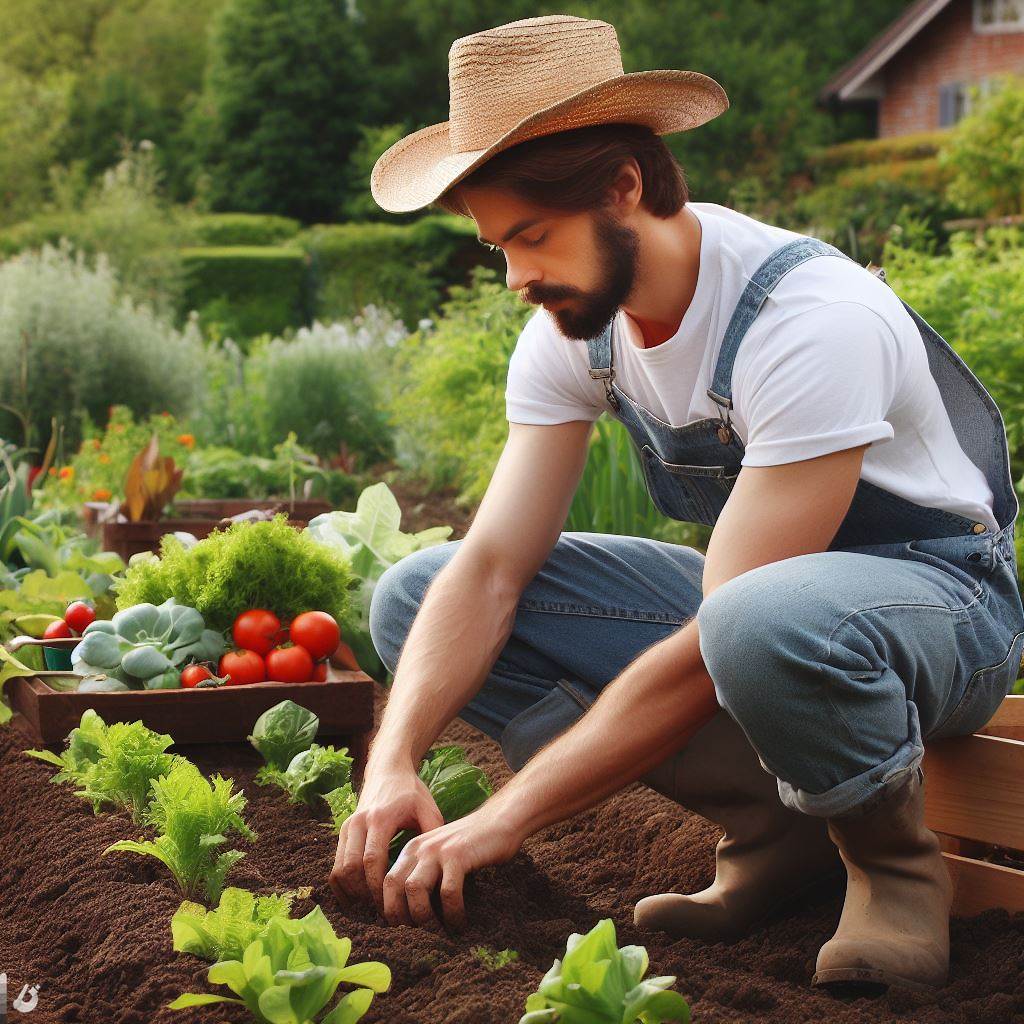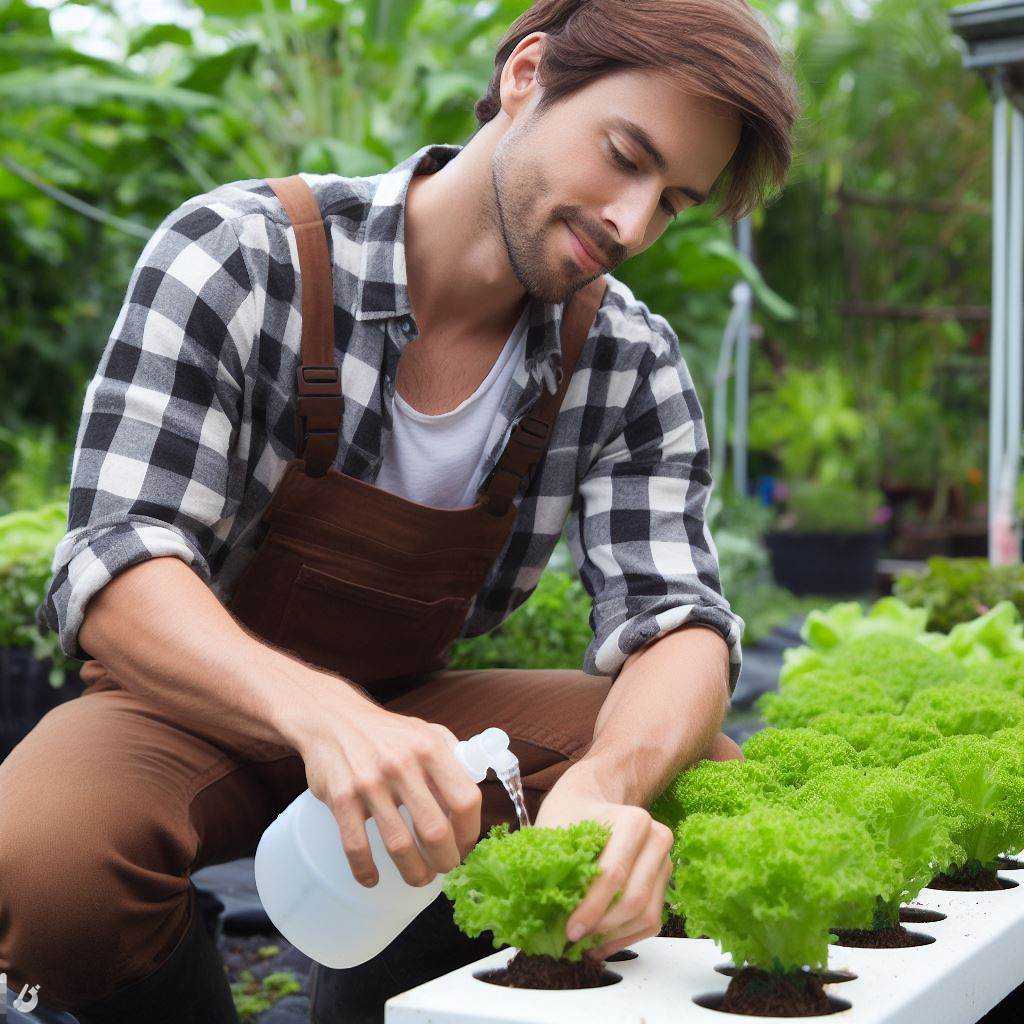Introduction
Urban farming is a growing trend in cities worldwide.
By cultivating food in urban areas, individuals can have a direct impact on their food sources.
Starting a city garden is crucial for several reasons.
Firstly, it allows individuals to grow their own fresh and healthy produce, ensuring a sustainable and accessible food supply.
It reduces dependence on commercial agriculture and decreases the carbon footprint associated with long-distance transportation.
Moreover, urban farming promotes community engagement and empowers individuals by providing them with the knowledge and skills needed to grow their own food.
City gardens also enhance the aesthetic appeal of urban areas and improve air quality.
This blog post aims to guide beginners through the process of starting a city garden.
It will provide practical tips on selecting the right location, preparing the soil, and choosing suitable crops.
Additionally, it will cover essential gardening techniques such as watering, fertilizing, and pest management.
Whether you have limited space on a balcony or a small backyard, this blog post will offer insights and strategies to help you successfully grow food in your urban environment.
Get ready to embark on an exciting journey as you connect with nature and become part of the urban farming movement.
Benefits of Urban Farming
Urban farming offers a multitude of benefits that extend beyond personal advantages.
The practice of cultivating food in urban areas has gained popularity in recent years, and with good reason.
Let’s delve into the various benefits that urban farming brings to individuals, communities, and the environment.
Transform Your Agribusiness
Unlock your farm's potential with expert advice tailored to your needs. Get actionable steps that drive real results.
Get StartedHealth benefits
Starting with health benefits, one of the major advantages of urban farming is access to fresh, nutritious produce.
By growing your own fruits, vegetables, and herbs, you can ensure that what you consume is free from harmful pesticides and chemicals.
This promotes a healthier diet, providing your body with essential vitamins and minerals.
Additionally, urban farming encourages increased physical activity.
From preparing the soil, planting seeds, watering plants, to harvesting the crops, every step of the urban farming process requires physical effort.
Engaging in these activities on a regular basis contributes to a more active lifestyle, benefiting both physical and mental well-being.
Environmental benefits
Moving on to environmental benefits, urban farming plays a significant role in reducing carbon footprint.
By growing food locally, there is a decreased need for long-distance transportation of produce.
This, in turn, reduces greenhouse gas emissions associated with food transportation, helping combat climate change.
Furthermore, urban farming promotes the preservation of green spaces.
Instead of turning urban areas into concrete jungles, utilizing available spaces for farming ensures the maintenance and creation of green areas.
This not only enhances the aesthetics of the city but also contributes to biodiversity by providing habitats for various plant and animal species.
Community benefits
Urban farming also brings substantial community benefits. Firstly, it helps in building stronger social connections.
When individuals come together to cultivate a shared community garden or participate in urban farming projects, they bond over a common purpose.
This fosters a sense of belonging, collaboration, and shared responsibility within the community.
Moreover, urban farming addresses food insecurity in urban areas.
Many urban communities lack access to fresh and affordable produce, leading to poor nutrition and health outcomes.
Urban farming provides an opportunity for residents to take control of their food supply, growing their own fruits and vegetables.
This empowers individuals and helps alleviate food insecurity in underserved neighborhoods.
In fact, urban farming offers a wide range of benefits encompassing health, environment, and community aspects.
It promotes access to fresh produce, encourages physical activity, reduces carbon footprint, preserves green spaces, builds social connections, and addresses food insecurity.
As more individuals and communities embrace urban farming, the positive impact on individuals’ well-being, communities, and the environment will continue to grow.
Read: Organic Farming: Basics for Small Plots
Choosing the Right Location
Choosing the right location for your urban garden is essential for its success.
Showcase Your Farming Business
Publish your professional farming services profile on our blog for a one-time fee of $200 and reach a dedicated audience of farmers and agribusiness owners.
Publish Your ProfileBy assessing the available space, researching local guidelines and regulations, and evaluating soil quality, you can ensure a flourishing city garden.
Assessing available space
When starting your urban garden, the first step is to assess the available space you have.
Whether you live in an apartment with a balcony, a building with a rooftop, or have some backyard space, these areas can be great options for urban farming.
By utilizing these spaces effectively, you can maximize the potential of your city garden.
Furthermore, it is crucial to consider factors such as sunlight exposure and accessibility.
Determine the amount of sunlight each specific area receives throughout the day. Most plants require a minimum of six hours of sunlight daily to thrive.
Additionally, consider the convenience of accessing your garden, ensuring that it is easily reachable for maintenance purposes.
Researching local guidelines and regulations
Prior to starting your urban garden, familiarize yourself with the local guidelines and regulations governing urban farming in your area.
Different cities and municipalities may have zoning requirements specifically tailored to urban agriculture.
Research and understand these zoning requirements to ensure compliance and avoid any legal issues in the future.
Additionally, check if you need permits or licenses to establish and maintain your city garden.
Some areas may require you to obtain specific permits, especially if you plan on selling produce or conducting educational workshops.
Make sure to understand the necessary paperwork and adhere to all the legal procedures.
Evaluating soil quality and composition
Soil quality plays a vital role in the success of your urban garden.
Before planting, it is essential to evaluate the soil’s quality and composition.
Performing soil tests will help identify if there are any contaminants present that may affect the growth of your plants.
If the soil quality is inadequate, consider soil amendments to improve its fertility and structure.
Composting, adding organic matter, or using commercially available soil conditioners can enhance the nutrients and water-holding capacity of the soil.
Alternatively, you can opt for container gardening, using raised beds or pots filled with high-quality soil mix, to bypass any soil-related challenges.
In essence, choosing the right location for your urban garden requires careful consideration.
Through assessing available space, researching local guidelines and regulations, and evaluating soil quality, you can create a thriving city garden and contribute to the sustainability of urban agriculture.
Selecting Suitable Crops
Choosing the right crops for your urban garden is a crucial step in ensuring its success.
With limited space and unique climate conditions in cities, it is essential to consider various factors to maximize yield and minimize maintenance.
Considering space limitations
- Compact or vertical gardening techniques: These innovative methods make the most of limited space by growing plants upwards or in small, condensed areas.
Options include using trellises, hanging baskets, and vertical towers to maximize vertical space and increase the number of plants you can grow. - Container gardening options: Containers provide a versatile solution for urban gardens, allowing you to grow crops in small areas such as balconies, rooftops, or even windowsills.
You can use planters, pots, or repurposed containers to cultivate vegetables, herbs, and even small fruit trees.
Climate considerations
- Matching crops to the local climate: It is crucial to choose crops that thrive in your specific climate for a successful urban garden.
Research which vegetables and fruits are well-suited to your city’s temperature range, rainfall, and sunlight availability. - Heat-tolerant or cold-tolerant varieties: Depending on the weather patterns in your city, select crop varieties that can withstand high temperatures or frost.
This ensures your plants will grow well and produce a bountiful harvest despite challenging weather conditions.
Identifying high-yield and low-maintenance crops
- Herbs and leafy greens: If you have limited space, consider growing herbs like basil, mint, or parsley, along with leafy greens such as lettuce, spinach, or kale.
These crops yield a significant harvest and require minimal maintenance, making them ideal for urban gardens. - Fast-growing vegetables: In urban settings where time might be a constraint, opt for fast-growing vegetables like radishes, arugula, or baby carrots.
These crops reach maturity quickly, allowing you to enjoy fresh produce within a short span, perfect for busy city dwellers.
By carefully selecting crops that suit your space, climate, and time availability, you can create a thriving city garden.
Remember to consider your personal preferences and culinary interests when choosing crops to ensure you enjoy the fruits of your urban farming endeavors.
Read: Water Scarcity in Farming: A Growing Concern
Preparing the Soil and Setting Up
When starting your urban garden, one crucial aspect to focus on is preparing the soil and setting up a suitable environment for your plants to thrive.
Proper soil preparation techniques, selecting appropriate containers, and setting up a water-efficient system are key elements to consider.
Soil preparation techniques
Before planting, it is essential to ensure that your soil is fertile and rich in nutrients.
One effective way to achieve this is through composting.
Composting involves the decomposition of organic matter, such as kitchen scraps and yard waste, into nutrient-rich compost.
By adding compost to your garden soil, you significantly improve its fertility and provide essential nutrients for your plants.
Mulching is another beneficial technique when preparing your soil.
Applying a layer of organic mulch, such as wood chips or straw, on top of the soil helps suppress weed growth by blocking sunlight and preventing weed seeds from germinating.
Mulching also helps retain moisture in the soil, reducing the frequency of watering and ensuring your plants have consistent access to water.
Selecting appropriate containers or raised beds
When gardening in an urban environment, space may be limited, making containers or raised beds a practical solution.
Consider the following factors when selecting the right containers or raised beds:
- Size and material considerations: Choose containers or raised beds that fit your available space and can accommodate the root systems of your chosen plants. Common materials include plastic, terracotta, or wooden containers.
- Drainage and irrigation options: Ensure that your containers or raised beds have proper drainage holes to allow excess water to escape. Additionally, consider installing irrigation systems such as drip irrigation to supply water directly to the plants’ root zones.
Setting up a water-efficient system
Water is a precious resource, and setting up a water-efficient system in your urban garden is crucial.
Consider the following techniques to maximize water conservation:
- Rainwater harvesting techniques: Install rain barrels or cisterns to collect rainwater, which can be used to irrigate your plants during dry periods. This reduces reliance on municipal water sources and helps conserve water.
- Drip irrigation or self-watering containers: Utilize drip irrigation systems that deliver water directly to the plants’ roots, minimizing water waste through evaporation or runoff. Alternatively, consider self-watering containers that have built-in reservoirs to provide water to the plants as needed.
By implementing these soil preparation techniques, selecting appropriate containers or raised beds, and setting up a water-efficient system, you’ll create an optimal environment for your urban garden.
Showcase Your Farming Business
Publish your professional farming services profile on our blog for a one-time fee of $200 and reach a dedicated audience of farmers and agribusiness owners.
Publish Your ProfileThese steps will not only contribute to the health and productivity of your plants but also help conserve water and make the most of limited space in a city setting.
Read: Gardening Tools: Must-Haves for Beginners

Planting and Maintaining Your City Garden
Planting and maintaining a city garden requires careful attention and consistent effort.
By following the right practices from the very beginning, you can set yourself up for a successful and bountiful harvest.
In this section, we will explore the essential steps involved in planting and maintaining your city garden.
Seed Selection and Starting
Choose Quality Seeds or Seedlings
When selecting seeds for your city garden, it is crucial to choose high-quality seeds or healthy seedlings.
Look for reputable seed suppliers or local nurseries that offer a wide variety of vegetable, herb, or flower seeds.
Opting for organic or heirloom seeds can ensure better taste and nutritional value in your harvest.
Indoor or Outdoor Germination Methods
Depending on your available space and climate, you can start germinating your seeds indoors or directly sow them in the garden.
Indoor germination gives you better control over temperature and moisture levels, resulting in stronger seedlings.
Outdoor germination, on the other hand, can save time and eliminate the need for transplanting.
Planting Techniques
Proper Spacing and Depth
Ensure proper spacing between your plants to allow for appropriate air circulation and avoid overcrowding.
Follow the instructions on seed packets or consult gardening references for specific spacing guidelines.
Additionally, plant your seeds at the recommended depth to allow for proper root development and initial growth.
Companion Planting for Pest Control and Nutrient Cycling
Implement companion planting techniques to naturally control pests and improve nutrient cycling.
Some plants repel pests, while others attract beneficial insects that prey on garden pests.
Additionally, certain combinations of plants enhance nutrient uptake and support each other’s growth.
Research companion planting arrangements suitable for your city garden to maximize its productivity.
Essential Garden Maintenance Tasks
Regular Watering and Fertilizing
Regular watering is essential for the health and development of your city garden.
Monitor soil moisture levels and adjust the frequency and amount of watering accordingly.
Additionally, fertilize your plants based on their specific nutrient requirements using organic fertilizers or compost.
This will ensure they receive the necessary nutrients for vigorous growth and abundant yields.
Weed and Pest Management Techniques
Keep your city garden free from weeds that compete with your plants for resources.
Regularly remove weeds by hand or use organic weed control methods.
Additionally, implement integrated pest management techniques to prevent and manage pest infestations.
Regularly monitor your plants for pests and use environmentally-friendly pest control solutions when necessary.
By following these planting and maintenance techniques, you can nurture a thriving city garden that provides you with fresh and nutritious produce.
Remember to adapt these practices to suit your specific urban gardening conditions.
The journey of growing your own food in the city is both rewarding and empowering.
Read: Container Gardening: Ideal for Small Areas
Harvesting and Enjoying the Fruits of Your Labor
Now that you have successfully cultivated your urban garden and watched your plants grow, it’s time to reap the rewards of your hard work.
Harvesting the crops and enjoying the delicious produce is an exciting and fulfilling process.
Here are some essential tips to guide you in harvesting and savoring the fruits of your labor:
Monitoring and assessing plant growth
To ensure optimal harvest, you must monitor and assess the growth of your plants regularly.
This will enable you to recognize the signs indicating that your crops are ready for harvest.
Observe the color, texture, and size of the fruits or vegetables.
Look for any visual cues that indicate maturity, such as when the fruits turn a vibrant color or the vegetables reach the desired size.
This close monitoring allows you to harvest your crops at their peak flavor and texture.
Another crucial aspect of assessing plant growth is preventing over-ripening or spoilage.
Some crops can quickly become overripe, resulting in a loss of taste and quality.
Showcase Your Farming Business
Publish your professional farming services profile on our blog for a one-time fee of $200 and reach a dedicated audience of farmers and agribusiness owners.
Publish Your ProfileRegularly check your plants and remove any overripe fruits or vegetables.
Additionally, pay attention to signs of spoilage, such as mold or discoloration. Promptly harvest and discard any spoiled produce to prevent the spread of diseases or pests.
Harvesting techniques
Proper timing and methods are vital when it comes to harvesting your urban garden’s crops.
Different plants have specific requirements for the best time to harvest.
For example, leafy greens should be harvested when the leaves are tender and young, while root vegetables should be harvested when they reach the desired size.
When harvesting, handle the produce gently to avoid bruising or damaging the plants.
Use sharp and clean tools, such as pruning shears or scissors, to ensure a clean cut and minimize stress on the plants.
Place harvested crops in appropriate containers, such as baskets or crates, to protect them during transportation.
After harvesting, it’s essential to store your produce properly to maintain its freshness.
Remove any damaged or infected parts before storing to prevent spoilage.
Different crops require different storage conditions, including temperature and humidity levels.
Research the specific storage methods for each crop and follow them accordingly.
Sharing and enjoying the bounty
The joy of urban farming is not limited to just personal consumption.
Share the bounty of your garden with friends, family, and neighbors. Host a harvest party or simply invite them over for a meal featuring your freshly harvested produce.
Sharing your hard work and delicious crops will not only bring joy to others but also strengthen your community bonds.
To further enjoy the abundance of your urban garden, explore diverse recipes that highlight the flavors of your harvest.
Experiment with different cooking techniques and ingredients to make the most of your fresh produce.
Additionally, consider preserving techniques such as canning, pickling, or freezing to extend the enjoyment of your harvest throughout the year.
Preserving your crops allows you to savor the taste of your urban garden even during off-seasons.
In summary, the art of harvesting and enjoying the fruits of your labor is a pivotal stage in urban farming.
By monitoring plant growth, employing proper harvesting techniques, and sharing the bounty with others, you can fully experience the rewards of your city garden.
So step into your garden, pick that perfectly ripe tomato or crisp lettuce, and relish the taste of your urban farm’s success.
Conclusion
Urban farming offers numerous advantages, such as fresh produce, community building, and environmental benefits.
It transforms city living.
Embark on your city garden journey. Convert balconies, rooftops, or windowsills into thriving green havens.
Don’t hesitate, start your own city garden and experience the joy of growing your own food.
The possibilities are endless.
To ensure urban farming success, remember to utilize proper resources and follow helpful tips from experienced gardeners.
- Utilize vertical gardening for limited space.
- Embrace container gardening for mobility.
- Opt for low-maintenance crops for beginners.
- Engage local communities for shared resources and knowledge.
- Explore online forums and urban farming blogs for inspiration.
Start your city garden adventure today, sowing the seeds of sustainability and reaping the harvest of urban farming success.




